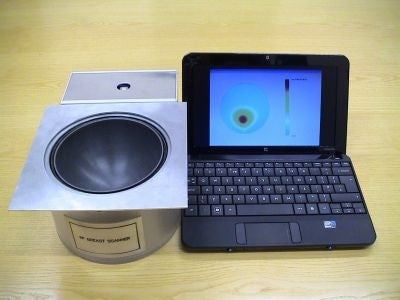Your support helps us to tell the story
From reproductive rights to climate change to Big Tech, The Independent is on the ground when the story is developing. Whether it's investigating the financials of Elon Musk's pro-Trump PAC or producing our latest documentary, 'The A Word', which shines a light on the American women fighting for reproductive rights, we know how important it is to parse out the facts from the messaging.
At such a critical moment in US history, we need reporters on the ground. Your donation allows us to keep sending journalists to speak to both sides of the story.
The Independent is trusted by Americans across the entire political spectrum. And unlike many other quality news outlets, we choose not to lock Americans out of our reporting and analysis with paywalls. We believe quality journalism should be available to everyone, paid for by those who can afford it.
Your support makes all the difference.Soon it may be out with mammograms and in with DIY breast scanners, from the comforts of your own home. A professor from the University of Manchester is developing a light, portable scanner that is easy to use and painless and detects the presence of breast cancer tumors in real time.
The scanner, about the size of a lunchbox, comes equipped with a breast scan cup. Once the breast is inserted, the scanner starts producing 30 images per second that are projected onto a screen. The presence of a tumor or other abnormality shows up in red (easy for an untrained eye to detect, sources say) as the sensor detects the difference in tissue contrasts at radio frequencies.
"The device is portable and light, and relatively inexpensive, so it is entirely practical to use in the home," writes University of Manchester spokesperson Daniel Cochlin via email. "This would serve as a first warning system," if a woman sees a red dot on the screen, indicating a tumor. "The next stage would be to contact a GP as a matter of urgency," he adds.
The scanner, reported to be a first of its kind, still needs to undergo clinical trials. Inventor Zhipeng Wu hopes his device will offer a quicker, less intrusive means of breast cancer testing outside of clinical settings, which could make it available to more women, more often, particularly in developing countries.
Using the scanner could also cut down on unnecessary doses of radiation from conventional X-ray mammography. Plus, while very effective in diagnosing women over 50, mammography sometimes misses the mark for younger women, and some suggest that radio frequency detection could offer more accuracy. Mammography is also not a real-time procedure, which can make it easier for a doctor to miss a problem.
Wu's scanner is another example of the burgeoning trend of DIY at-home medical devices. Also in the works is a bathroom mirror, being developed by a student in the Harvard-MIT Health Sciences and Technology program, that can measure vital signs - pulse, respiration, and blood pressure - allowing around-the-clock monitoring in real time for those who need it.
The H'andy sana 210, tagged as a "doctor in your pocket," is a device that allows heart patients to remotely monitor their heart by recording a real-time ECG (electrocardiogram) and send it to a health professional.
http://www.manchester.ac.uk/aboutus/news/display/?id=6282

Join our commenting forum
Join thought-provoking conversations, follow other Independent readers and see their replies
Comments